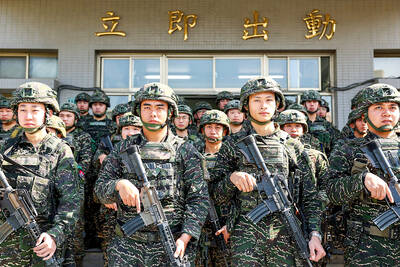“If disobedient, beat my kid to death,” (孩子不乖你打乎死) was, a decade or more ago when corporal punishment was an accepted part of school life in Taiwan, a common parental aphorism.
How times have changed. The development of the country’s education system forms the basis of Wei Jun-zhan’s (魏雋展) play Punish (罰), one of 10 solo performances by local artists beginning this weekend and lasting until Nov. 9, at Guling Street Theater.
“Today it’s more like, ‘touch my child and you’ll get sued,’” said River Lin (林人中), paraphrasing another of the play’s central conceits.
Lin, MOVE Theatre Group’s (動見体劇團) producer and the brains behind Fable To Be or Not To Be (漢字寓言:未來系青年觀點報告), challenged 10 performance artists to come up with a Chinese character that they think best symbolizes Taiwan.
“The idea came from online surveys that asked people to choose a particular [Chinese] character to describe a country for that year,” Lin said.
Citing one of last year’s surveys, Lin said respondents chose “rise” (漲) for China, “fake” (偽) for Japan and “disorder” (亂) for Taiwan.
The production sees choreographers, theater professionals, poets and multimedia artists coming together under one roof for solo performances — lasting roughly 20 minutes each — to convey their ideas about anything from entertainment to the economy.
Each performance features works by five of the artists. This weekends’ performers include actress Chou Heng-yin (周姮吟), whose work Struggle (掙) investigates gender bias in Taiwan. Huang Si-nong (黃思農) will play the erhu (二胡), a traditional Chinese fiddle, in her performance Forget (忘), a psychedelic rock number that looks at the popularity of talent shows such as One Million Stars (超級星光大道).
Chou Shu-yi’s (周書毅) Yield (讓) opens next week’s five performances. The choreographer combines mime with modern dance to examine how the meaning of the Chinese character has changed over time — from its Confucian roots meaning facing the world with humility, to its contemporary usage (often used by the bodyguards of politicians or celebrities pushing through a media scrum) meaning, “get out of the way.”
Lin chose “end” (末).
“As in the end of the world, or end of the Earth,” he said. When I pointed out that this was a rather pessimistic word to pick, he countered by referring back to the title of the performances.
“It’s the kind of thinking we hope to change through these performances. That’s why we called it Fable To Be or Not To Be … because its not the end of the world and it doesn’t have to be,” he said.

That US assistance was a model for Taiwan’s spectacular development success was early recognized by policymakers and analysts. In a report to the US Congress for the fiscal year 1962, former President John F. Kennedy noted Taiwan’s “rapid economic growth,” was “producing a substantial net gain in living.” Kennedy had a stake in Taiwan’s achievements and the US’ official development assistance (ODA) in general: In September 1961, his entreaty to make the 1960s a “decade of development,” and an accompanying proposal for dedicated legislation to this end, had been formalized by congressional passage of the Foreign Assistance Act. Two

President William Lai’s (賴清德) March 13 national security speech marked a turning point. He signaled that the government was finally getting serious about a whole-of-society approach to defending the nation. The presidential office summarized his speech succinctly: “President Lai introduced 17 major strategies to respond to five major national security and united front threats Taiwan now faces: China’s threat to national sovereignty, its threats from infiltration and espionage activities targeting Taiwan’s military, its threats aimed at obscuring the national identity of the people of Taiwan, its threats from united front infiltration into Taiwanese society through cross-strait exchanges, and its threats from

Despite the intense sunshine, we were hardly breaking a sweat as we cruised along the flat, dedicated bike lane, well protected from the heat by a canopy of trees. The electric assist on the bikes likely made a difference, too. Far removed from the bustle and noise of the Taichung traffic, we admired the serene rural scenery, making our way over rivers, alongside rice paddies and through pear orchards. Our route for the day covered two bike paths that connect in Fengyuan District (豐原) and are best done together. The Hou-Feng Bike Path (后豐鐵馬道) runs southward from Houli District (后里) while the

March 31 to April 6 On May 13, 1950, National Taiwan University Hospital otolaryngologist Su You-peng (蘇友鵬) was summoned to the director’s office. He thought someone had complained about him practicing the violin at night, but when he entered the room, he knew something was terribly wrong. He saw several burly men who appeared to be government secret agents, and three other resident doctors: internist Hsu Chiang (許強), dermatologist Hu Pao-chen (胡寶珍) and ophthalmologist Hu Hsin-lin (胡鑫麟). They were handcuffed, herded onto two jeeps and taken to the Secrecy Bureau (保密局) for questioning. Su was still in his doctor’s robes at